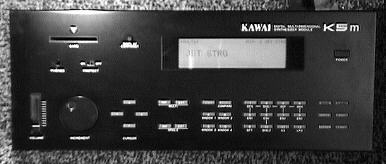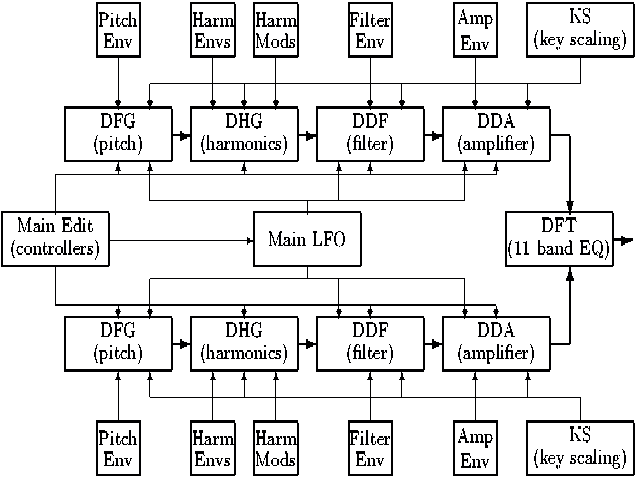the K5 geek page
Ever heard of the Kawai K5 additive synth?
Ever wondered what it is like?
Here are the answers to all the questions you never cared to ask!
If you enjoy playing - or better: programming! - the Kawai K5,
an obsolete synthesizer, a complete failure on the synth market,
a noisy thin sounding device that needs a totally anal-retentive
lunatic to program it, this page is for you.
By the way, you may also want to check out the page for the
Kurzweil K150 Fourier Synthesizer.
Kawai K-5 Additive Synthesis Keyboard and
Kawai K-5m Multidimensional Synthesizer Module (long live marketing!).

Hardware and user interface
The keyboard version has 61 keys (5 octaves) with attack and release velocity
and monophonic aftertouch, there is a pitchbend and a modulation wheel.
The module (K5m) is a 4 height units rack device which also can be used
standalone like a console.
All the other features are identical for both keyboard and module version.
There are mono 5 outputs: 4 polyhonic individual outs which can be assigned
in Multi mode and are always active in Single mode and one Mix output.
There is the MIDI in/out/thru trio, jacks for expression (#11) and
foot pedal (#4) and jacks for sustain/hold switch (#64) and for a
Link footswitch that can be programmed to step through configurable sequences
of 8 programs.
The user interface consists of a data entry wheel, bank select and patch
select buttons, cursor arrows and buttons for global functions.
Also there is one master volume and a switch to protect all memory settings.
The huge LCD display has graphics for some parameters but not for the
envelopes.
Unfortunately the display has a very limited viewing angle.
Another drawback is that the cursor gets lost easily and the arrow buttons
are not always intuitive to use.
The synthesis architecture
The K5/K5m is 16 voice polyphonic and 15 part multitimbral.
There are 48 Single and 48 Multi patches in internal memory plus
the same number storable on RAM card.
Each Single patch contains 2 sections which are usually layered
(Twin mode) for two oscillators with 63 harmonics but also may be stacked
(Full mode) to get 126 harmonics.
Global per Single are the portamento - which works very well -
the main LFO and the DFT, a virtual 11 band EQ, all other parameters are
controllable per section.

Envelopes: Per section there are a pitch envelope, 4 harmonics envelopes, a filter envelope and an amp envelope. Each of these has 4 levels/rates plus 2 levels/rates for release, unfortunately only the pitch envelope can be looped. The amp envelope has one additional release rate and for each of its rate parameters and you can individually switch velocity control on/off.
Harmonics: The harmonics editor features a graphic display and some nice editing macros: you can e.g. edit only the even harmonics between 44 and 60 with relative emphasis on the lower ones. For dynamical sounds each harmonic is assigned to either one of the 4 modulation pathes or to no madulation at all (which gives full level). Each modulation path has its own harmonics envelope (see above) plus a LFO with only frequency control.
Filter/EQ: Has controls for cutoff frequency, slope and flat level which means it is can be shaped from a lowpass to something like a bandpass. The sound is strange and very different from what you would expect. The 11 band graphic EQ (called DFT) is nice but works with strange frequencies (from ~ 25 Hz to ~ 5 kHz). Since the K5 does have very little bass this doesn't really make sense.
Multi mode: The Multi mode implementation is very nice: for up to 15 parts you can define the Single patch, the MIDI channel, polyphony (dynamical or number of voices) transposition/tuning note and velocity ranges and lots of controller filters.
Sound
First: the K5 is noisy, has a relatively low output level,
very little bass (some people told me they disagree on this point)
and not much treble (maybe up to 10 kHz or so).
The individual outs and the Multi mode are a little less noisy though
and you can try a hardware modification.
If you use the K5 with other noise makers you will generally use the Multi
mode for a richer stereo sound.
What the K5 is good at are bright digital sounds:
think of bells&chimes, metallic whisper, synth choirs and brittle digital
textures.
To me the machine sounds like a typical early digital synth with lots of
aliasing, harsh quantization and the like.
However it layers very nicely with soft analog-style pads and leads
and may cut through your mix if you use it where it shines.
It is also so thin sounding, even the 16 voice chorus of my SE-70 changes
little of its character.
In short: I absolutely love the sound.
Successor: K5000S
Around 1999, Kawai offered a serias of successors t the K5: the K5000. I own a K5000S (the additive keyboard version). The sound is interesting, but bears relatively little resemblence to the K5. Of course noise level and general synthesis abilities are much better, the exception being the envelopes which lack some of the flexibility of the K5.
Support
If you want to download sounds and documentation for the K5/K5m here is a zip of all the stuff I have:K5 files
Leslie Sanford oreo@eaze.net provided a K5 wavemaker program for the Atari.
It seems Kawai still supports K5/K5m users with ROMs, manuals and even schematics. the latest ROM version for the K5m is 1.2 (at least my 1.2 ROM says "K5m final").
K5 Hack page, KULT5000, The Kawai K3 page, Music Machines, electronica, Analogue Heaven
Find out about commercial K5 PC Software (or mail to baw@efn.org).
Thanks to Andrea Toni for lots of infos and to Andrew (synth.site) for the picture.